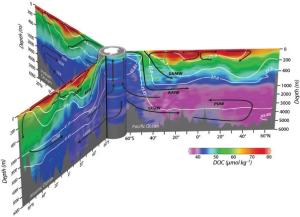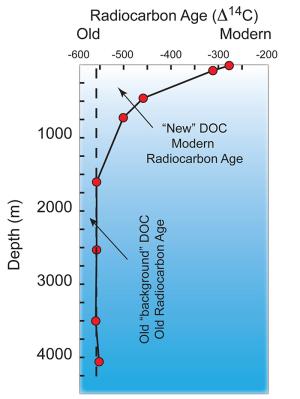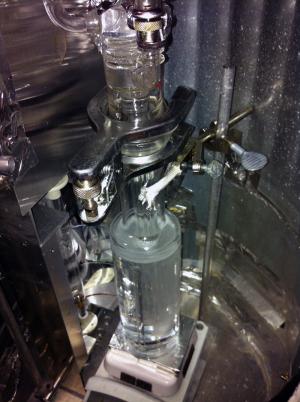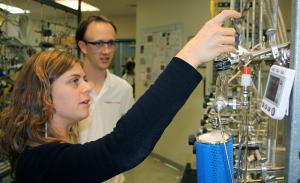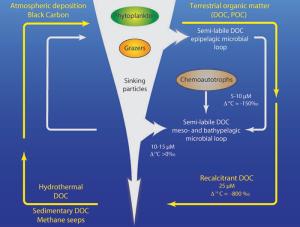Radiocarbon and the deep ocean cycling of dissolved organic matter
A major challenge in marine chemistry is to understand how carbon cycles in the deep ocean. The deep ocean is cold and dark, but it is also where most ocean carbon resides. Our understanding of deep ocean carbon cycling is very limited, and we need a better appreciation of how deep sea biogeochemical cycles impact global climate and habitability.
Marine dissolved organic carbon (DOC) is one of the planet’s largest reservoirs of carbon, comparable in size to carbon stored in terrestrial plants, soil organic matter, and the atmosphere. Global oceanographic surveys carried out over the last two decades have provided a detailed picture of both the reservoir size and water column distribution of DOC, a synopsis of which is provided in Figure 1. As shown in the figure, DOC concentrations are high in surface waters, but decrease with depth. This distribution tells us that DOC is produced in the surface, removal at intermediate depths, and removed very slowly in the deep ocean. We can learn more about how carbon is cycled in the ocean by using radiocarbon dating techniques to determine the ‘age’ of DOC. Radiocarbon dating of marine DOC yields an average age of 2000-3000 years in the surface ocean and approximately 5000-6000 years in the deep ocean (Figure 2). This suggests that a large amount of DOC survives for a long time before it is finally removed from the ocean.
However, this broad-brush picture of carbon cycling in the ocean overlooks many important aspects of how carbon is produced, transported, and ultimately sequestered. The simple profile of total DOC radiocarbon shown in Figure 2 masks a much more interesting and complex cycling of carbon, especially in the deep ocean where several different fractions of DOC with different radiocarbon values may co-exist. DOC radiocarbon measurements are made by irradiating seawater with high intensity ultraviolet light. UV radiation converts organic carbon to carbon dioxide, which is recovered and measured for radiocarbon (figs 3, 4). Joint Program student Chris Follett recognized that much more information about carbon cycling could be extracted from radiocarbon measurements if they were done in a step-wise fashion. If we adjust the intensity of ultraviolet light, or the irradiation time, we can selectively oxidize targeted fractions of DOC. We are beginning to learn how to manipulate the UV oxidation technique and with this new approach in hand, we are beginning to see the outlines of a deep sea carbon cycle (Fig. 5) that is far richer, and more complex than revealed by DOC concentration maps and total radiocarbon measurements alone.
